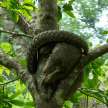Phước Bình National Park
Phước Bình, Bác Ái District, Ninh Thuận Province, Vietnam

Phước Bình National Park is a national park located in the commune of Phước Bình, Bác Ái District, Ninh Thuận Province, Vietnam. It lies 62 kilometers northwest of Phan Rang town, the capital of Ninh Thuận Province, and shares its border with Lâm Đồng and Khánh Hòa provinces. Established in 2006, this park covers a total area of 19,814 hectares and serves as a vital biodiversity corridor and core habitat. It also holds significant cultural history for local ethnic communities.
The park is situated on the eastern slopes of the Đà Lạt plateau, straddling the transition area between three regions: southeast, south-central, and the Central Highlands of Vietnam. Dominated by several high peaks in the west (reaching up to 2,200 meters above sea level), the eastern part gradually descends toward the coastal plain of south-central Vietnam.
Here are some key details about Phước Bình National Park:
Classification: Originally designated as a nature reserve by Decision 125/2002/QD in September 2002, it was later upgraded to a national park by Decision 822/QĐ-TTg in June 2006, signed by then Vice Prime Minister of Vietnam, Nguyễn Tấn Dũng.
Biodiversity: The park boasts over 1,225 plant species and 327 animal species, many of which are included in the IUCN Red List. It plays a crucial role in protecting the Cai River watershed, which supplies water to the entire province of Ninh Thuận, an arid region in Vietnam.
Historical Significance: Within the park, you’ll find the historic wartime battlefield at Pi Nang Tac’s stone trap, where over 100 soldiers lost their lives during the Vietnam War in 1965. Pi Nang Tac led the guerrilla army’s battle to construct an ambush stone trap.
Contiguity: Phước Bình National Park is contiguous with Bi Doup – Nui Ba National Park in Lâm Đồng Province to the west, forming an essential ecological corridor.
Whether you’re a nature enthusiast, a history buff, or simply seeking breathtaking landscapes, Phước Bình National Park is a must-visit destination in Ninh Thuận.
Javanese Pangolin Conservation: Safeguarding a Unique and Endangered Species
The Javanese pangolin (Manis javanica), native to the lush forests of Java, Indonesia, is a remarkable creature facing critical threats to its survival. As the world’s most trafficked mammal, the pangolin’s existence hangs in the balance due to illegal wildlife trade and habitat degradation. Let us delve into the urgent need for conservation efforts to protect this scaly wonder.
Understanding the Pangolin:
Pangolins are ant-eating mammals covered in keratin scales, which act as armor against predators.
They are predominantly nocturnal and notoriously shy, making them challenging to study.
There are eight pangolin species globally, with four found in Asia and four in Africa.
All pangolin species are listed under Appendix I by CITES, signifying the same level of protection as rhinoceroses.
Why Are Pangolins at Risk?:
Pangolins face high rates of trafficking for their scales and meat.
Despite their ecological importance, little is known about their behavior and habitats.
Local markets overexploit pangolin populations, while Asian markets drive illegal international trade.
Human-induced problems, such as habitat fragmentation and loss, further threaten their survival.
Conservation Strategies:
Active Field Research: Organizations like the Pangolin Conservation & Research Foundation (PCRF) conduct field research to understand pangolin behavior, ecology, and distribution.
In-Situ Conservation: Protecting pangolins within their natural habitats is crucial. Collaborations with local communities and enforcement agencies help safeguard these elusive creatures.
Policy Advocacy: Partnerships inform policies and guidelines to combat illegal trade and protect pangolins.
Education and Awareness: Raising awareness about pangolins’ vulnerability is essential. Outreach programs dispel myths and emphasize their ecological significance.
Community Engagement: Empowering locals to participate in pangolin conservation fosters a sense of ownership and responsibility.
Challenges and Solutions:
Habitat Restoration: Reforestation projects are vital to restore natural habitats where pangolins can thrive.
Legal Measures: Stricter laws, penalties, and enforcement are necessary to deter poachers and traders.
Research Focus: Understanding pangolin biology informs targeted conservation strategies.
In-Situ vs. Ex-Situ Conservation: Balancing protection within natural habitats and ex-situ programs (zoos, sanctuaries) is crucial.
International Collaboration: Sharing knowledge and resources globally enhances conservation efforts.
The Call to Action:
The plight of the Javanese pangolin demands comprehensive action.
Governments, NGOs, and local communities must unite to ensure pangolins not only survive but thrive for generations to come.
In this race against time, let us champion the cause of the Javanese pangolin, preserving its uniqueness and securing its place in our shared natural heritage.
About the Creator
Luong luu van
Phước Bình National Park is a national park located in the commune of Phước Bình, Bác Ái District, Ninh Thuận Province, Vietnam.






Comments (1)
Wow seem cool! Well written!